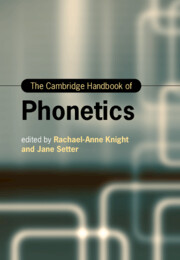Book contents
- The Cambridge Handbook of Phonetics
- Cambridge Handbooks in Language and Linguistics
- The Cambridge Handbook of Phonetics
- Copyright page
- Contents
- Figures
- Tables
- Contributors
- Introduction
- Section I Segmental Production
- Section II Prosodic Production
- Section III Measuring Speech
- 10 Measuring Vowels
- 11 Measuring Consonants
- 12 Measuring Speech Rhythm
- 13 Fundamental Frequency and Pitch
- 14 Observing and Measuring Speech Articulation
- 15 Beyond Functional Speech Synthesis
- Section IV Audition and Perception
- Section V Applications of Phonetics
- Index
- References
14 - Observing and Measuring Speech Articulation
from Section III - Measuring Speech
Published online by Cambridge University Press: 11 November 2021
- The Cambridge Handbook of Phonetics
- Cambridge Handbooks in Language and Linguistics
- The Cambridge Handbook of Phonetics
- Copyright page
- Contents
- Figures
- Tables
- Contributors
- Introduction
- Section I Segmental Production
- Section II Prosodic Production
- Section III Measuring Speech
- 10 Measuring Vowels
- 11 Measuring Consonants
- 12 Measuring Speech Rhythm
- 13 Fundamental Frequency and Pitch
- 14 Observing and Measuring Speech Articulation
- 15 Beyond Functional Speech Synthesis
- Section IV Audition and Perception
- Section V Applications of Phonetics
- Index
- References
Summary
The observation and measurement of the movement of the organs of the vocal tract during speech is relevant for the understanding of phonetic phenomena, from descriptions of under-documented languages and cross-linguistic comparison of speech sound production, to investigations of factors impacting speech motor planning, and to testing models of the relationship between the vocal tract and acoustics. This chapter describes the most commonly used methods for measuring or recording the position and movements of the organs that make up the vocal tract during speech. Techniques discussed in this chapter include direct vocal tract imaging (e.g. magnetic resonance imaging (MRI), laryngoscopy, ultrasound imaging), articulatory point tracking (e.g. X-ray microbeam tracking (XRMB), electromagnetic articulography (EMA), Velotrace), and indirect measures of articulator movement (e.g. electroglottography (EGG), airflow and air pressure measures, static palatography and electropalatography (EPG)). These methods vary in a number of respects. This chapter discusses advantages and drawbacks of each method described, as well as factors relevant to researchers during the planning stages of a study.
- Type
- Chapter
- Information
- The Cambridge Handbook of Phonetics , pp. 362 - 386Publisher: Cambridge University PressPrint publication year: 2021
References
14.7 References
- 1
- Cited by



